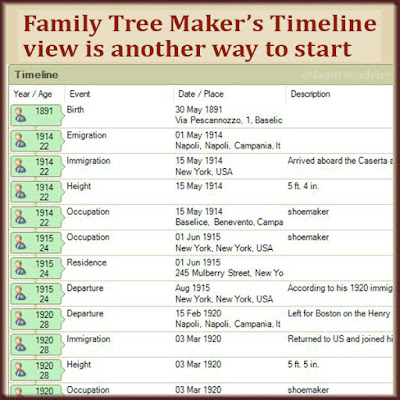Sometimes your family tree research can uncover uncomfortable secrets.
Growing up, my mother had a cousin who was her dear friend. But she had no idea how they were cousins. My mom would tell me, "Oh, she's a Saviano, but I don't know how."
 |
| Angela's identity became clear when I spoke to my mom's 3rd cousin. |
When this cousin asked me to look into her family tree, I learned about her tragic grandmother, Angela Letizia Saviano.
- On 21 May 1898, Angela sailed from Italy to New York. She was with my great great grandfather, Antonio Saviano, his wife and 2 of his children.
- Angela was 18 years old and from the same small town as my Saviano family.
- She listed another of Antonio Saviano's children as her cousin.
- Antonio Saviano was her uncle; Angela's grandparents were my 3rd great grandparents.
- Angela's 1880 birth record shows that her mother had the same last name as my grandmother. Was she a double cousin?
- Angela married a man from the same little town, and her mother-in-law was on that ship in 1898, too.
- Angela had one child, a daughter Catherine, in New York City in 1899.
- Angela died at the age of 21 of a leaky heart valve. She'd been under a doctor's care for 1 month.
Angela's only daughter is the reason my mom's cousin "was a Saviano." Angela was this cousin's grandmother.
 |
| One of my 1st genealogy finds had the mysterious Angela. |
Last week this same cousin asked if I'd found out anything about her father's side of the family from Bari in Italy.
I can do that research now. With online access to Italian birth, marriage and death records, it should be easy. (If you have any Italian ancestors, find out about the Antenati site.) I started by looking at the U.S. documents I'd collected for my cousin's father and his brothers. I had their names and approximate ages, their father's name (Francesco), and their hometown (Alberobello).
I searched the Alberobello birth records for the 3 brothers and found them all. Now I knew their mother's name was Isabella. But there was something unusual written on the side of the first-born son's birth record.
 |
| It's right there on his birth record: his parents married later. |
Vincenzo's 1891 Birth
His birth record said his parents married in December 1891—that's 6 months after he was born. It says they got married to make this baby legitimate.
OK, maybe that's not such a big deal (although this was 1891). But the couple's marriage document shows that the mother of the baby—the new bride—was 14 years old. The father, Francesco, was 25.
As ewww as that is, there's more. Francesco first got married in 1888 to a woman who must have died by mid- to late-1890. And while this wasn't uncommon, the then 13-year-old girl he got pregnant in late 1890 (that part IS uncommon) was the half-sister of this first wife.
How do you think that went? The little girl is consoling him over the loss of his wife, her sister, and it winds up getting physical? Bye-bye childhood, Isabella. It's mommy time.
Francesco's 1866 Birth
I found one more twist to this tale. Another shotgun wedding. Francesco, who made baby Vincenzo with 13-year-old Isabella, was also born out of wedlock. His birth record also says that his parents married to make the baby legitimate.
Francesco's father, also named Vincenzo, was 30 years old when he married for the first time. His wife, already the mother of his child, was a widow and only 23 years old. Maybe this is how they consoled widows and widowers back in the day!
My cousin who wanted this information isn't online. I'll have to print out the information and documents and mail them to her. I'm still trying to figure out how to lay out these facts as clinically as possible.
I want to keep digging into this family's vital records. I'd like to find the relationship between Francesco's grandmother and Isabella, his child bride. They have the same last name. (Of course they do.)
I'm expecting a few more plot twists ahead.









